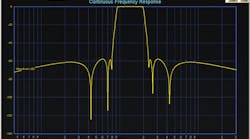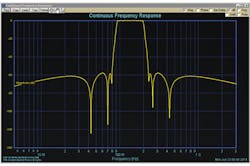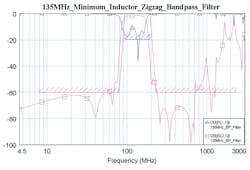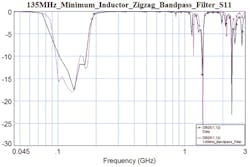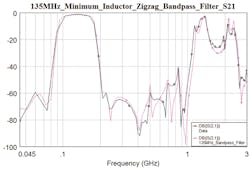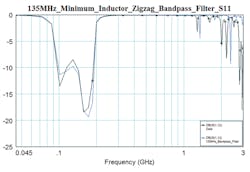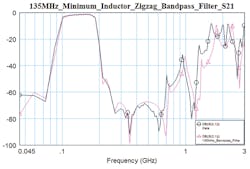Synthesize Filters with Wideband Success
This file type includes high resolution graphics and schematics when applicable.
Filter designers for RF/microwave requirements have long been challenged with meeting an often-conflicting set of performance demands. Often a final RF/microwave filter design is the result of a tedious, iterative process. Fortunately, computer-aided-engineering (CAE) software tools continue to improve and a new semi-automated filter design and layout procedure may help ease the journey to that final filter.
The procedure involves the integrated use of three commercial software tools and separately addresses filter synthesis, working with component models, and performing accurate circuit and electromagnetic (EM) analysis on the design. To demonstrate the effectiveness of the new procedure, a bandpass filter was synthesized from the models, with measured results impressively close to the predictions in a single design pass.
Filter synthesis is rarely easy or automatic, even for an experienced filter designer. Starting with just basic filter types—such as bandpass, bandstop, highpass, and lowpass filters—and then trying to achieve a particular set of performance parameters for one of these filter types, can turn into an almost endless iterative design process, with some designers always tempted by the challenge of achieving slightly more rejection or slightly less loss.
As some designers learn, often the simplest and most straightforward design approach builds upon a classic filter architecture. Still, classical filter topologies can suffer from any number of drawbacks that must be tackled, such as an excessive number of inductors and the need to account for circuit element losses, pad parasitics, lead parasitics, substrate effects, and interconnect effects. Failure to take any of these into account during the design process can lead to poor performance in the fabricated filter and failure to meet the target performance requirements.
Fortunately, modern CAE software tools continue to improve, creating filter designs in which computer predictions come consistently close to the measured results when those designs are finally fabricated in microstrip, stripline, or other high-frequency circuit technology. For example, such tools as Filter Solutions fron Nuhertz Technology, coupled with component and device models such as the Global Models from Modelithics, can greatly assist filter designers in need of shaving time and effort from the traditional iterative filter design process.
Filter Solutions, as the name implies, contains design functions and routines aimed at helping experienced and novice filter designers alike. The software also makes it possible to semi-automate the design process and drastically reduce the time required to take a filter from an initial design to a practical layout and fabricated component or circuit.
What makes this design software even more effective is the use of advanced measurement-based equivalent circuit Global Models from Modelithics, which accurately account for the parasitic effects of the components and circuit elements representing the filter design. By means of collaborative efforts between the two companies, they have even demonstrated excellent wideband results in the design, fabrication, and testing of five different lumped-element filters.
In using a combination of software-based tools such as the Filter Solutions software and the Modelithics models, the design process starts by establishing and entering design requirements into the filter design software, such as filter center frequency, passband bandwidth, and stopband attenuation. A designer must select a filter type (such as bandpass, bandstop, etc.), topology, and other design options; the software will suggest a filter design based on ideal components.
A desired substrate material and the Modelithics models are then selected and the design schematic diagram and layout will be exported to Microwave Office from AWR for further analysis. The AWR software will predict the impact of parasitic effects that might have been missed earlier in the design process (which are included in the Modelithics models) and plot the expected results (Fig. 1).
This file type includes high resolution graphics and schematics when applicable.
Resulting Changes
This file type includes high resolution graphics and schematics when applicable.
Changes that can occur due to this software “fine-tuning” can include, as in this case, a shift of the entire filter passband to a lower frequency range from the ideal filter response presented earlier. The AWR schematic diagram must go through several optimizations to correct for this frequency shift, first for component part values, after which the Filter Solutions software will select the closest available component part values and update the schematic circuit diagram and then optimize the circuit for such things as interconnection line lengths and widths.
The Filter Solutions software then automatically produces a layout for a filter schematic diagram so that once the filter has been optimized, it is ready to be fabricated. This straightforward design process helps to eliminate guesswork and greatly simplify a normally quite iterative filter design process.
To demonstrate the effectiveness of this filter design process, a 135-MHz minimum-inductor zigzag bandpass filter was designed with the Filter Solutions software and the Modelithics device and circuit-element models. The 135-MHz bandpass filter was built and tested, well beyond its nominal passband, to 3 GHz. This was done to study not only the passband response, but also to check the accuracy of the out-of-band response. Throughout the frequency range evaluated, the measured filter response agrees quite closely with the simulated filter response (Fig. 2).
Although designed and fabricated for a relatively low passband of 135 MHz, the filter’s response in the stopband was correctly predicted (compared to the fabricated filter) across a very wide frequency range. When this is compared to the results from ideal models (Fig. 3), the simulated passband response appears to be quite close to the responses from the ideal models, despite the slight shift in the frequency range of the passband. However, the out-of-band responses based on the ideal models shows an over-estimation of performance past 1 GHz.
Success in filter synthesis depends on a large number of variables, during the initial design stages but also at the layout stages. To demonstrate, the 135-MHz filter was simulated with a different layout and compared to the measured response of the original design (Fig. 4). The filter’s passband is somewhat broader and shifted lower in frequency for this new layout. Although the out-of-band performance shows a similar trend in the simulation, for this new layout it is completely shifted towards a lower-frequency range.
Fortunately, by using software design tools such as Filter Solutions with accurate Global Models from Modelithics, the effects of parasitic circuit elements, substrates, and even layouts can be handled and accounted for in a single design cycle. This helps to greatly simplify the entire RF/microwave filter design process.
Editor’s Note: An AWR project file containing this filter, as shown in Fig. 5, is available upon request from Modelithics. An application note with additional filter examples will soon be available from the firm’s website.
Isabella Delgado, Engineering Intern
Laura Levesque, Application Engineer
Larry Dunleavy, President & CEO
Modelithics, Inc., 3802 Spectrum Blvd., Ste. 130, Tampa, FL 33612; (813) 866-6335, FAX: (813) 866-6334
Jeff Kahler, President & Chief Technical Officer
Nuhertz Technologies, LLC, 1 East Camelback Rd., Phoenix, AZ 85012; (602) 279-2448
References
1. A. Pietrikova, K. Ruman, I. Vehec, and P. Galajda, “Design of low pass filter for UWB application,” 35th International Spring Seminar on Electronics Technology (ISSE), September, 2013.
2. K. Ruman, A. Pietrikova, I. Vehec, and P. Galajda, “Comparison of different materials for manufacturing of antialiasing LP filter,” 2013 International Conference on Applied Electronics (AE), Pilsen, Czech Republic, September 10-12, 2013.
This file type includes high resolution graphics and schematics when applicable.
